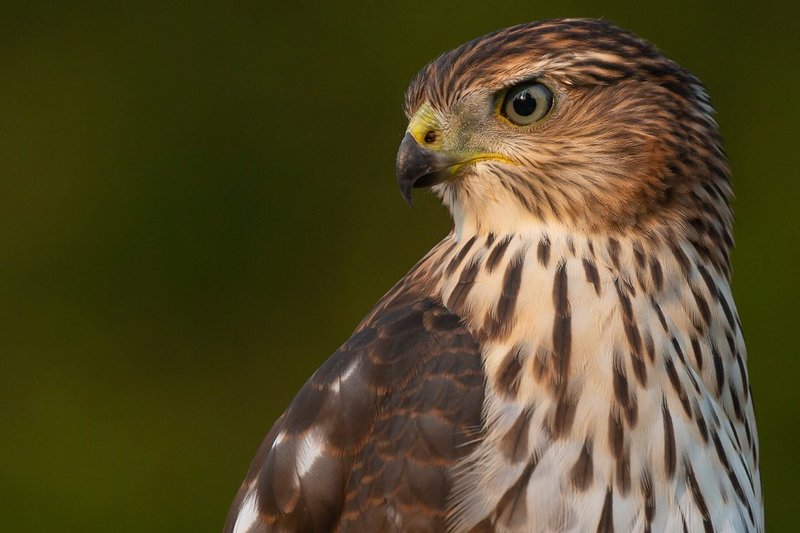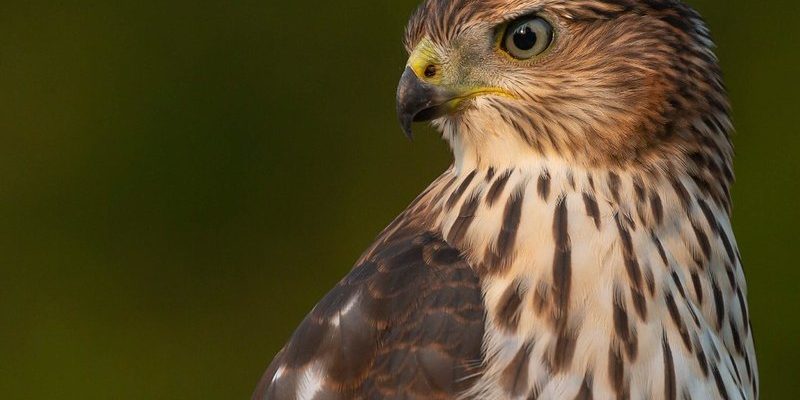
The Cooper’s Hawk, known scientifically as *Accipiter cooperii*, is a remarkable bird that has adapted to life in urban and suburban environments, often surprising those who enjoy birdwatching. So, grab a cup of coffee, and let’s dive into some lesser-known facts about this enigmatic raptor that might just make you rethink what you know about these incredible birds.
1. A Master of Speed and Agility
One of the most striking features of the Cooper’s Hawk is its impressive flying skills. These birds can reach speeds of up to 50 miles per hour when diving to catch their prey. Imagine a racecar whizzing by; that’s the intensity of their flight! Their long, pointed wings and long tails help them maneuver expertly through wooded areas, making sudden changes in direction to pursue elusive prey.
What sets them apart from other hawks is their unique hunting technique. They often chase smaller birds, using their agility to zip through trees and shrubs. Their ability to navigate tight spaces is so impressive that it often leaves birdwatchers in awe. Honestly, it’s like watching a well-rehearsed dance as they expertly weave in and out of branches!
2. Size and Appearance
The Cooper’s Hawk is medium-sized, typically measuring about 14 to 20 inches in length. Think of it as a slightly smaller version of a Red-tailed Hawk. Their size can be a bit confusing at first because females are larger than males. Typically, females weigh about 1.5 to 3.5 pounds, while males weigh around 1 to 2 pounds.
Their distinctive appearance includes a bluish-gray back and reddish-orange stripes on their chest. This unique coloring helps them blend into their surroundings, making them less noticeable to both prey and predators alike. If you’ve ever spotted one perched quietly, you know how well their plumage camouflages them against the backdrop of a dense forest.
3. A Social Hunter
You might think of hawks as solitary creatures, but the Cooper’s Hawk can actually be quite social. During the breeding season, they often engage in enthusiastic courtship displays, which can include aerial acrobatics and vocalizations. Picture a couple of performers putting on a show for each other—these displays are all about attracting the right mate!
In their family groups, you can often see juveniles hanging around with their parents after they’ve fledged. This behavior allows the young hawks to learn the ropes of hunting and survival skills, which is pretty important for their development. It’s kind of heartwarming to think about how these hawks support one another as they grow up.
4. Adaptable Diet
The Cooper’s Hawk is a true opportunist when it comes to food. Although they primarily hunt small to medium-sized birds, such as sparrows and robins, they don’t shy away from a variety of other snacks. They’re known to eat mammals, reptiles, and insects when the opportunity arises. You might be wondering why this matters—well, their adaptability helps them thrive in various environments, from dense forests to urban landscapes.
This flexibility in diet allows them to survive even when their preferred prey is scarce. It’s a bit like having a favorite dish but being perfectly happy to enjoy leftovers when necessary. Their hunting prowess is a testament to their resourcefulness, making the Cooper’s Hawk a fascinating example of wildlife resilience.
5. Urban Dwellers
Believe it or not, the Cooper’s Hawk is one of the few raptors that has successfully adapted to life in urban areas. You might spot them perched on the edge of a tall building or soaring over parks in bustling cities. Their ability to adapt to human environments is pretty remarkable.
This urban presence has led to some exciting birdwatching opportunities. Many bird enthusiasts now seek out Cooper’s Hawks in cities—it’s a thrilling experience to see these majestic birds against a backdrop of skyscrapers. They’ve managed to carve out a niche in this concrete jungle, reminding us that nature finds a way, even in the most unlikely places.
6. Nesting Habits
Nesting is a crucial part of a Cooper’s Hawk’s life. They typically build their nests high in trees, using sticks and branches to create a sturdy platform. These nests can be quite large, sometimes reaching up to three feet across! If you ever find yourself hiking through their territory, keep an eye out for these impressive nests high in the treetops.
Interestingly, the female does most of the nesting work, which allows the male to focus on hunting to provide food for the family. You might think of it as a team effort, where each parent has its own vital role to play. Their commitment to raising their young together is a beautiful aspect of their behavior.
7. Unique Vocalizations
The Cooper’s Hawk is known for its distinctive vocalizations, which can often be heard during the breeding season. Their calls are sharp and high-pitched, giving them a unique sound that sets them apart from other birds. If you’ve ever listened to them, you might compare their calls to a series of rapid “kak-kak,” almost like a bird version of a rapid-fire text message.
These vocalizations are used for different purposes, including attracting mates and defending territory. Just like we use our voices to communicate, these hawks rely on sound to convey important messages to one another. It’s a reminder of how critical communication is in the animal kingdom.
8. Conservation Status
The Cooper’s Hawk is currently listed as a species of “Least Concern,” meaning they are relatively stable in terms of population. However, that doesn’t mean they’re completely free from threats. Habitat loss and pesticide use can impact their numbers over time. It’s crucial to be mindful of how our actions can affect these beautiful creatures.
Conservation efforts are essential for maintaining healthy hawk populations. Supporting local wildlife organizations or participating in birdwatching activities can help raise awareness and contribute to the preservation of habitats. Every little bit counts when it comes to protecting our feathered friends!
9. The Role of Cooper’s Hawk in Ecosystems
Cooper’s Hawks serve an important role in their ecosystems as predators. By controlling populations of smaller birds and rodents, they help maintain a balanced food web. Without predators like them, certain species could overpopulate, leading to a cascade of negative effects on the ecosystem.
By observing their behaviors and interactions with other species, researchers can gain valuable insights into the health of our environments. It’s a reminder that even the smallest animals can play a significant role in the larger picture—and why appreciating and protecting them is so important.
10. How to Spot a Cooper’s Hawk
If you’re eager to catch a glimpse of a Cooper’s Hawk, there are a few tips to keep in mind. First, look for them near wooded areas, parks, or backyards—they tend to prefer places with plenty of cover to navigate while hunting. Early mornings or late afternoons are often the best times for spotting them, as they’re most active during those hours.
When observing their behavior, pay attention to their flight patterns. Their quick, flapping flight followed by a glide is a hallmark of their hunting style. And don’t forget to listen for their distinct calls—an auditory clue that a Cooper’s Hawk might be nearby. So grab your binoculars and get ready for some exciting birdwatching!
In conclusion, the Cooper’s Hawk is a fascinating and adaptable bird that truly deserves more attention. From their impressive hunting skills to their unique nesting habits, there’s so much to appreciate about this raptor. Next time you’re outside, take a moment to look up—you might just spot one soaring above, reminding us of the beauty and resilience of nature.

